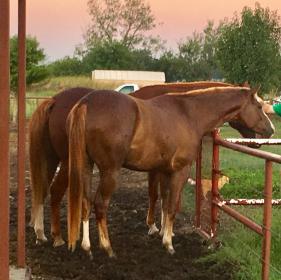Honestly; I think it would be rare to find just due to the way embryos develop. Granted, most of my knowledge on white pattern genes is how to INCREASE color (paint breeder) and avoiding the dreaded “almost a paint, but ain’t” that has leg white, but nothing above the knees/hocks.
"White markings in horses are formed when pigment producing cells (melanocytes) fail to migrate to their final location on an animal. The areas that are left without pigment producing cells remain white. Because pigment producing cells always migrate the same way, the areas of the body which are reached last by these cell during development are the areas of the body that are most likely to be white, ie the head and legs."1
I’m not a biologist, so I don’t know how horse embryos develop past the point of what we see in various textbooks. I haven’t studied it, for sure, but it seems likely that face and hind leg white would occur prior to front leg white. I’ve seen plenty of horses with hind leg only white; but none that I can recall that didn’t at least have some kind of coronet white on the back if their fronts were white.
Lately, there’s been decent discussion on the W20 gene which is responsible for high whites in multiple different breeds. I have several examples of W20 horses standing out in my pastures - the two photographed below have been genetically tested to carry only one copy of W20 – no other known white pattern gene exists in either of them. W20 could be responsible for a lot of the “chrome” you tend to see in multiple breeds - but again, it tends to show on all of the legs, versus just the front two.
In this photo, the mare up front has been tested to carry n/W20. She ALSO has a small belly spot, which is pictured. Her son, behind her, is the closest I have to a horse that has front white but not hind white - his right rear is just a small coronet white, but his left does extend up. He has NOT been genetically tested (he’s a gelding, so…) but he does have a blue eye, which is not a trait of W20. [ATTACH=JSON]{“alt”:“Click image for larger version Name: 38023576_10102025631200819_314240925729554432_o.jpg Views: 2 Size: 29.1 KB ID: 10306387”,“data-align”:“center”,“data-attachmentid”:“10306387”,“data-size”:“full”,“title”:“38023576_10102025631200819_314240925729554432_o.jpg”}[/ATTACH]
The mare below is my three year old, who has one hind sock. She’s also been genetically tested to be n/W20. [ATTACH=JSON]{“alt”:“Click image for larger version Name: 42135609_10102067747659099_6462436053893513216_n.jpg Views: 1 Size: 16.8 KB ID: 10306388”,“data-align”:“center”,“data-attachmentid”:“10306388”,“data-size”:“full”,“title”:“42135609_10102067747659099_6462436053893513216_n.jpg”}[/ATTACH]
There are a couple of photos I found online of horses that appear to have white on the front only - but without being able to see the other side of the horse or their midline (white likes to show up under the belly!) then you can’t really say for certain that it’s the only white on the horse.
I’d definitely assume it’s unusual based on my knowledge of how white develops in utero!
1 [URL=“https://colorgenetics.info/equine/study-face-and-leg-white-horses-reveals-influence-new-and-known-loci”]https://colorgenetics.info/equine/st...and-known-loci
http://equinetapestry.com/2014/03/the-w20-project/





